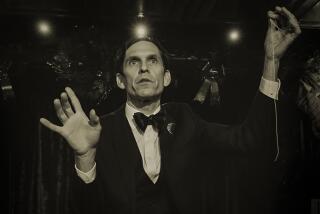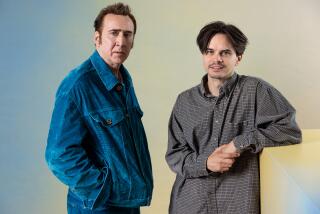Jim Carrey haunts and is haunted
Charles Dickens’ most popular creation, Ebenezer Scrooge, usually takes on the tenor of the times, so it’s not surprising that Robert Zemeckis’ new performance-capture animation version of “A Christmas Carol” has its star, Jim Carrey, musing about where his Scrooge fits in today.
“I was thinking about it this morning, how this story ties into everything we’re going through,” says Carrey, who, thanks to the technology, plays Scrooge as well as the three ghosts haunting him. “Every construct we’ve built in American life is falling apart. Why? Because of personal greed and ambition. Capitalism without regulation can’t protect us against personal greed.”
Zemeckis’ movie, arriving Friday in both conventional and 3-D formats, remains faithful to the spirit of Dickens’ novella while leaving room for the sort of flights of fancy you might expect from a Disney-branded entertainment. Scrooge hangs onto his humbug, but also rides a giant icicle as if he’s competing in an Alpine luge event. The spirits are in your face and scary but remain well within the bounds of PG entertainment.
“Everybody likes a good ghost story, but we kept it light,” Zemeckis says, speaking in a conference call with Carrey. “Think of it as the Haunted Mansion version.”
For the director, part of the appeal in putting what he calls the “graphic novel” version of “A Christmas Carol” on the screen came from the material’s compatibility with digital filmmaking. Much of the movie takes place in candlelit shadows or the waning light of London, restrained settings that benefit from animation’s ability to capture subtle atmospheres.
That kind of thing might not necessarily excite people who found Zemeckis’ previous two efforts in the motion-capture medium -- adaptations of “The Polar Express” and “Beowulf” -- to be unappealing compromises between animation and live action. But Zemeckis has his boosters too and, as he notes, the technology’s capabilities “multiply by 10 times every year.”
That means “A Christmas Carol” might be the first performance-capture movie for which no one complains about creepy-looking characters and “dead eyes.”
There is, of course, a fair amount of death in a story that Dickens opened with the line: “Marley was dead: to begin with. There is no doubt whatever about that.”
In the film, we first meet Scrooge at the undertaker’s as he painfully parts with two gold coins to pay for his business partner’s burial. That Scrooge evens things out by lifting the coins covering Marley’s eyes is one of many added touches that establish the character’s pinched spirit.
“Scrooge is the ultimate example of self-loathing,” Carrey says, noting that, after playing the title character in Ron Howard’s “How the Grinch Stole Christmas,” he was merely “going to the source” in fleshing out Scrooge.
“Beware the unloved, I always say,” Carrey continues. “They’re the ones that end up being the mean guys. It comes from that deep, spiritual acid reflux within them. With Scrooge, it infects his whole being.”
Scrooge isn’t the only one haunted in this “Carol.” After Marley’s initial late-night warning, Scrooge looks out his window and sees a galaxy of ghosts, moaning and groaning, lugging around lockboxes and ledger books.
“They’re all chained to the character defect they had in life, and now they’re paying for it,” Zemeckis says.
The spirits haunting Scrooge hew closely to Dickens’ descriptions, particularly the Ghost of Christmas Past, a man-child crowned with a “bright clear jet of light” so otherworldly that the book’s original illustrator, John Leech, didn’t even attempt to draw it. Wearing a performance-capture suit, Carrey played all three, moving from that impish Past to the jolly giant Ghost of Christmas Present to the Grim Reaper-like specter of Christmas Yet to Come.
“You watch Jim’s movies, and he’s moving every single muscle,” Zemeckis says. “I knew he’d be a natural at this.”
“It was crippling, basically,” Carrey interjects, laughing. “It’s the reason there’s never been a Fire Marshal Bill movie. I couldn’t take it.”
Having one actor play Scrooge and the ghosts makes sense, Zemeckis says, because the whole story is likely a bad dream brought on by a bout of indigestion.
“The spirits are all part of his psyche,” Zemeckis says. “They’re familiar because they’re a part of him, so they all look kind of like him -- except for the last one. That’s the Scared Straight Ghost.”
And by that point, Carrey says, Scrooge is ready to be pushed into the light. That moment of clarity still produces a lump in the throat some 166 years after Dickens wrote it.
“I had somebody close that I was not spending enough time with, and I saw them slipping away and, in fact, thought at one point they did,” Carrey says. “They didn’t, so I lived it without having it be my destiny. I think, if you’re lucky, you get to have a kind of ‘Christmas Carol’ moment once in your life.”
--
More to Read
Only good movies
Get the Indie Focus newsletter, Mark Olsen's weekly guide to the world of cinema.
You may occasionally receive promotional content from the Los Angeles Times.











